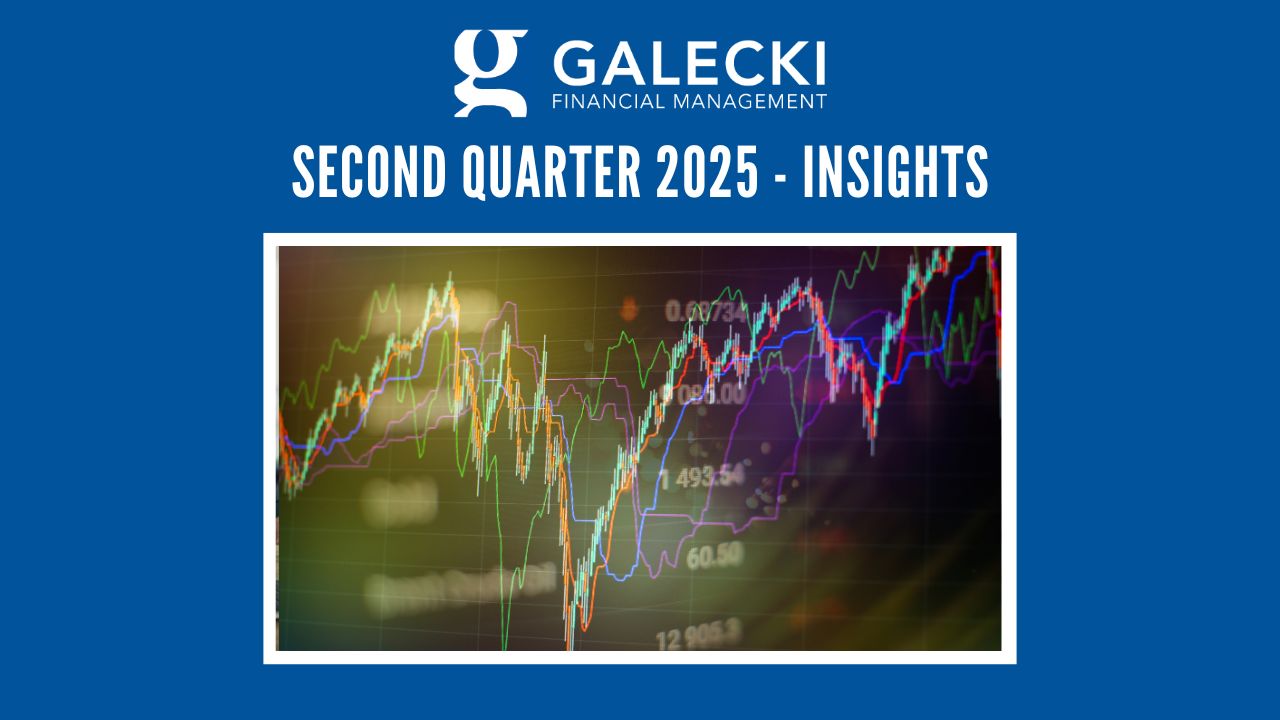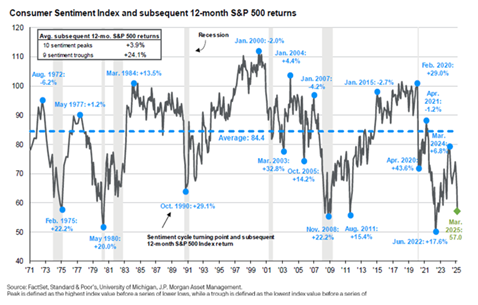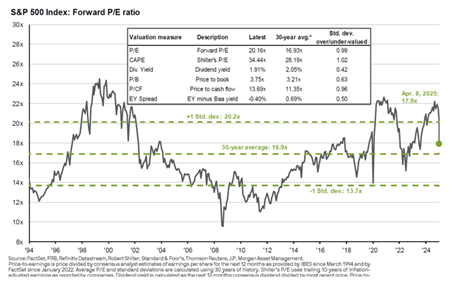

Index Returns
As Ross Geller famously stated on Friends…”PIVOT! PIVOT!” What was up in 2024 is now down in 2025, and vice versa. The S&P 500 dropped by 5.63% in the quarter, powered by major drops in the Magnificent 7 stocks. The Russell Midcap Index dropped 3.40%. The Russell 2000 Index declined almost 7% in March and finished the quarter with a decline of 9.48%. Commodities were up by nearly 5% in the first three months. Most of this advancement was due to an increase in the price of Gold and Silver.
International stocks are flexing their muscles with strong relative outperformance so far this year. The MSCI EAFE Index gained 6.86%, led by Europe’s gain of 10.48%. Emerging Markets also offered diversification benefits with a gain of 2.93% in the first quarter. Real Estate had a solid start to the year with a gain of 3.49%.
Bonds rallied in the quarter with a renewed outlook for three rate cuts from the Federal Reserve. The Barclays Aggregate Bond Index rose 2.78%. Global bonds also gained 2.07% in the first three months.
Economic Review and Outlook
“Patience is not simply the ability to wait, it is how we behave while we are waiting.” This is a quote we have always liked by Joyce Meyers. Market volatility has risen due to uncertainty around trade tariffs, inflation, the labor market, consumer spending, and a corresponding economic slowdown. While it might be our instinct to react to each new piece of information, it is much more prudent to be patient and keep a long-term focus.
So, let’s focus on the actual current data. Economic growth was steady in 2024, and we finished with a growth rate of 2.4% in the last quarter. Indications are that the first quarter GDP number will be right around 0%. A large portion of this was due to imports in January, which were quite high in expectation of future tariffs. Imports detract from GDP. Early indications are for a similar growth rate in Q2 as consumers have started to pull back spending.
The Federal Reserve is also in a holding pattern. Inflation is hovering around 2.6% annually, which is close to the Fed’s target of 2.0%. The market now expects the Federal Reserve to make three cuts in 2025 with the first to come in June. This is all with an expectation that our economy will slow down and need a little boost.
The Leading Economic Index decreased by 0.3% in February to 101.1 following a 0.2% decline in January. Industrial Production increased 0.7% in February. The Capacity Utilization Rate (which measures how much slack is in the economy) moved up to 78.2%, which is now very close to full capacity and could be a sign of inflation.
Non-farm payrolls rose by 228,000 in March and the unemployment rate remains at 4.2%. Weekly unemployment claims were 219,000 for the week ending March 29, 2025. The 4-week moving average is at 223,000. There are 7.7 million job openings in the U.S. It is important to remember that the unemployment rate is a lagging indicator. Although a weaker economy typically triggers a higher unemployment rate, the massive drop in immigration may keep the labor force thin, causing the rate to hold steady.
Manufacturing registered 49.0% on the ISM PMI Index in March. This was a drop of 1.3% from February and is in contraction territory. The New Orders Index came in at 45.2%, which was 3.4% lower than February. The ISM Services Index was at 50.8% in March, which is barely in expansion territory. The Business Activity Index came in at 55.9%, which was 1.5% higher than the prior month. New Orders for the service sector came in at 50.4%, which was 1.8% lower. The Employment Index was at 46.2% and represents a drop of 7.7% from February, which is significant.
The JPM Global Manufacturing PMI was at 51.6 in March. The Euro area is at 50.4, while Emerging Economies are growing at 52.4, led by India at 58.6 and Brazil at 55.1. Growth outside of the U.S. remains stable.
Equity and Bond Markets
The first quarter was quite volatile for equities here in the U.S. with the S&P 500 declining more than 4%. Then things got even more volatile in the first two weeks of April. As of April 8th, the S&P 500 was down roughly 15%, with large-cap growth stocks and small-cap equities declining more than 20%. In fact, the Magnificent 7 stocks were down more than 25% year-to-date. Investors are concerned that the imposed tariffs could tip the U.S. and the global economy into a recession. While the probability of a recession is growing, it is not a guarantee. This market could be one social media post or White House briefing away from a swift rebound.
We wrote the above paragraph around 11:00 a.m. ET on April 9th. On April 9th, the S&P increased substantially in the final four hours of trading, ending the day up 9.5%, due to an announced 90-day pause in most tariffs. This was a real-time example of how timing the market never historically works for investors. “Time in the Market Is More Important than Timing the Market.”
There is some good news that we wanted to highlight in the two charts below. Consumer sentiment has plummeted to an extreme low. This is a contrarian indicator for the market. Going back to 1971, the S&P 500 has averaged a 24% return over the next 12 months when a trough has been reached.

In addition, the high valuations we have been so concerned about have become much more reasonable after this decline. The forward P/E ratio for the S&P 500 is now down to 17.9 times earnings, which is very close to the 30-year average.

International Markets continue to outperform domestic stocks. The All-Country World Index ex-U.S. currently has a P/E ratio of 12.3 times earnings versus a 20-year average of 13.1 times earnings. This means that international stocks are very cheap from a long-term valuation perspective. There is no doubt that Canadian and Mexican markets could struggle if we do not reach tariff agreements with them. But the rest of the world is not as reliant on the U.S. and should continue their outperformance. This is why markets in Spain, Italy, and Germany are up 21%, 17%, and 15%, respectively.
The bond markets have also been erratic recently. There has been heavy selling in U.S. Treasuries, and there is speculation that China may be unloading some of their holdings into the market. The Federal Reserve is being pressured to cut rates, but they would much rather sit on their hands and see how this plays out before they act. If the economy begins to falter, they will likely step in and cut short-term interest rates 3-4 times in the second half of the year. If inflation heats up due to the tariffs, they will be unable to cut rates and might even need to raise them. Therefore, it will be equally important to stay diversified on the fixed-income side of the portfolio and maybe even add in some alternative investments to reduce correlations.
Portfolio Management
The Investment Committee continues to monitor the economy, the market, and the portfolio allocations. The economy does appear to be slowing. We are likely to see almost no economic growth in the first half of the year. The second half of the year could be a different story. The 2017 tax cuts are likely going to be extended in some fashion. We could also see some additional tax cuts on things like Social Security income or tips. There is also the possibility of a DOGE dividend at some point. This would be a big boost for lower-income households. In addition, the Federal Reserve may lower rates in the second half of the year, giving the economy a further tailwind.
Therefore, this is not the time to panic. Panic is not an investment strategy. There are some concerns in the economy, and this is putting pressure on the markets. At the end of the day, once the rules have been set, companies will figure out how to play in the new environment. They will then work on growing revenue and earnings. It just might take some time.
The fixed-income side of the portfolio is finally showing its worth. Offering principal protection and income is the reason investors should hold bonds in their portfolios. This has been critical so far this year.
Any changes we do make will be tactical in nature as we will not try to “time the market.” We are long-term investors and will do our best to ignore the short-term volatility we could see over the next six months.
Financial Planning
An important piece of a comprehensive financial plan is preparing for the unexpected. A death, disability, or an extended stay in long-term care can upend financial lives.
Life Insurance: We view life insurance solely as insurance, never as an investment. For individuals still in the accumulation phase of their financial life, with a spouse, children, or others dependent on their income, some type of term life insurance is likely needed. Term insurance provides a death benefit for a specified number of years for an agreed-upon price. For example, a 30-year $1.0 million term life insurance policy will pay the beneficiary $1.0 million if the insured dies within those 30 years (if the annual premium is paid). There is no cash value on these types of polices. It works similarly to a homeowner’s policy: you pay the premium with no other “benefit” received. You pay your homeowner’s policy to protect your home, but if your home never burns down, you probably don’t feel those dollars were “wasted.” Life insurance, in most cases, should be used as income replacement and financial protection.
Disability Insurance: If you work for an employer, you likely have group disability insurance available as a part of your benefits package. Typically, we see 60% of salary covered up to a certain dollar amount each month. If you are highly compensated, you may need additional private disability insurance to protect your income. Physicians should explore purchasing private Own Occupation disability insurance. Own Occupation will pay a physician disability income if they cannot perform their particular job duties (such as surgical procedures) even if they can earn an income in another way (such as teaching).
Long Term Care Insurance: This type of insurance is more complex and is best reviewed as a part of a comprehensive financial plan. There are various ways to plan for an extended long-term care stay and insurance may or may not be necessary depending on your specific goals and objectives.
If you, or someone you know, is beginning to explore retirement, assisted living facilities, the following website provides unbiased recommendations: ECDOL.org. Excellent Care, Decency, & Optimal Living (ECDOL) does not receive payment from the providers they recommend. There is a state-by-state directory of senior living providers.
Company News
Our renovation project wrapped up in February and we are enjoying the new look of our space. Thank you to all our clients for bearing with us as we worked through the dust and debris. We shared more photos of our main-floor renovation on our social media channels. Here are links to see more: Facebook Photos LinkedIn Photos

Before

After
